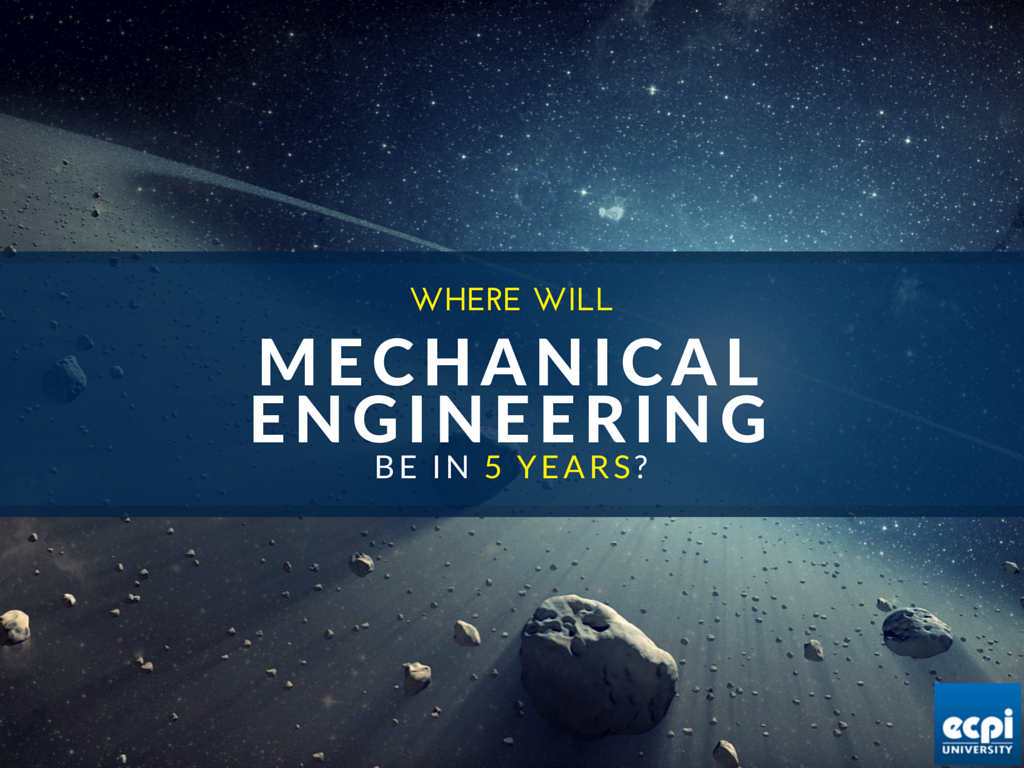
Where Will Mechanical Engineering Technology Be in 5 Years?
The field of mechanical engineering is directly aligned with the needs of human civilization, and humanity in turn has become dependent on its ability to harness the forces of physical reality. Thus, global civilization now finds itself looking to future technology to solve the problems that afflict it today.
Mechanical engineering has pervaded nearly every aspect of modern societal infrastructure; even as the digital age unfolds, society’s dependence on advancements in the fundamental field is, and will remain, constant.
From myoelectric prosthetics and perpetual printing to space-age ventures and nanotechnology, the next five years will see many projects in the sub-disciplines of mechanical engineering come to fruition, irreversibly changing the way we live.
Mechatronics & Mechanical Engineering
Mechanical engineering in respect to electrical and telecommunications technology has been responsible for advances such as computer-aided and integrated manufacturing systems. These are indispensable to nearly every production-heavy industry, the military, and the development of medical technology. Robotics is a sub-discipline of mechatronics and the key field in the development of modern prosthetics.
- Myoelectric Prosthetics involve the use of electrical sensors on the site of an amputated limb. The sensors read and interpret muscular activity and then direct a command to the prosthetic. This type of technology has only been available to select patients so far, but leading prosthetics manufacturers like Myomo in Cambridge, MA have just been granted patents and expect the mechanisms to be readily available within five years.
- Perpetual Printing promises to eliminate the burden of endless ink cartridge refills and wasted printer paper. To accomplish this task a handful of well-funded companies have developed a rewritable plastic paper named gyricon. On the microscopic level the paper consists of cavities each filled with a substance that reacts to electronic stimulus. The affectation changes the color of the substance in the cavity, and can also be used to erase it. Companies like Fuji Xerox and Sanwa Newtec are amongst those racing to make this technology viable for the consumer market.
Mechanical Engineering is Changing Aerospace
The term 'space-age technology' seems to have never lost its relevance, and with good reason. The myriad challenges presented with just attaining orbit has forced engineers to think outside the box and develop innovative and cutting-edge technology.
- Airborne Launch Assist Space Access (ALASA) is a program of the U.S. military’s Defense Advanced Research Projects Agency (DARPA) that has developed a method of launching satellites into orbit via F-15 fighter planes. This method of satellite delivery will come at a fraction of the cost of using conventional rockets.
- Planetary Resources is a company with bold ambitions, substantial funding, and a staff of mechanical engineers that has become the envy of the world. The company’s mission is to prospect and extract resources, such as metals and minerals, from near-earth asteroids. They are developing their technology internally, from the ground up, and on the way to their lofty goals. Planetary Resources has simultaneously endowed the world with radical advancements in 3D printing, optics, communications, energy efficiency, and satellite imaging.
Nanotechnology
The engineering and manipulation of matter at the molecular and atomic scale has led to breakthroughs in the manufacture of fabrics and textiles that all but define modern sporting goods and clothing, but the real potential of nanotechnology is on the horizon.
- Nanotube processing has been theorized for some time as being the ideal replacement for silicone in the manufacturing of computer chips. Silicone’s capacity for the transistors that make modern computing possible has been nearly exhausted. This is a scary prospect for the consumer market, which has depended on a steadily doubling in computing power every two years. IBM has been the first to put carbon nanotubes to the test for commercialization.
In November of 2015, the International Mechanical Engineering Congress and Exposition (IMECE) will take place in Houston, TX. This meeting of the minds is globally recognized as the foremost gathering of interdisciplinary mechanical engineers. It is there that the visions of yesterday are announced as today’s reality, and the technological dreams of tomorrow, see their genesis. However, it is often a characteristic of mechanical engineering that a new discovery will alter the course of technology, affect all of the sub-disciplines, and defy projections.
Are You Ready?
As these advances continue, companies will rely on mechanical engineering technicians to make sure everything runs properly. If you would like to learn more about this exciting field, contact ECPI University. Through our year-round program, you can earn a Bachelor of Science in Mechanical Engineering Technology in just 2.5 years.
DISCLAIMER – ECPI University makes no claim, warranty or guarantee as to actual employability or earning potential to current, past or future students or graduates of any educational program we offer. The ECPI University website is published for informational purposes only. Every effort is made to ensure the accuracy of information contained on the ECPI.edu domain; however, no warranty of accuracy is made. No contractual rights, either expressed or implied, are created by its content.
For more information about ECPI University or any of our programs click here: http://www.ecpi.edu/ or http://ow.ly/Ca1ya.


